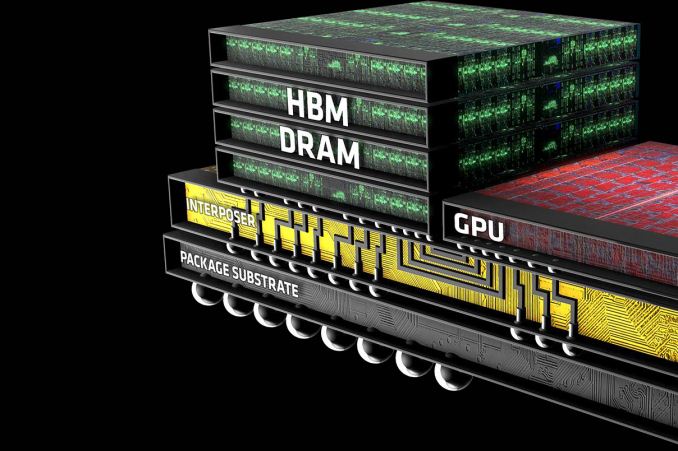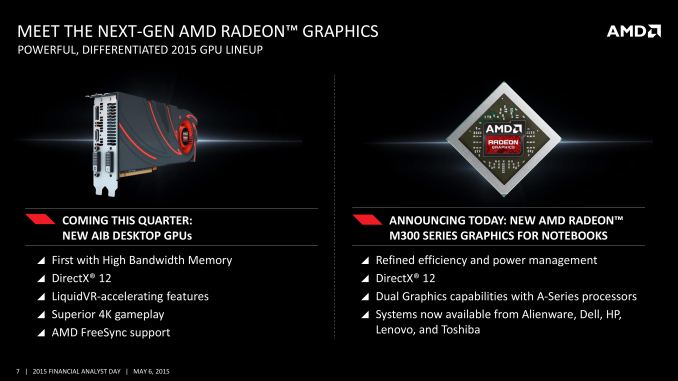AMD Dives Deep On High Bandwidth Memory - What Will HBM Bring AMD?
by Ryan Smith on May 19, 2015 8:40 AM EST
Though it didn’t garner much attention at the time, in 2011 AMD and memory manufacturer Hynix (now SK Hynix) publicly announced plans to work together on the development and deployment of a next generation memory standard: High Bandwidth Memory (HBM). Essentially pitched as the successor to GDDR, HBM would implement some very significant changes in the working of memory in order to further improve memory bandwidth and turn back the dial on memory power consumption.
AMD (and graphics predecessor ATI) for their part have in the last decade been on the cutting edge of adopting new memory technologies in the graphics space, being the first to deploy products based on the last 2 graphics DDR standards, GDDR4, and GDDR5. Consequently, AMD and Hynix’s announcement, though not a big deal at the time, was a logical extension of AMD’s past behavior in continuing to explore new memory technologies for future products. Assuming everything were to go well for the AMD and Hynix coalition – something that was likely, but not necessarily a given – in a few years the two companies would be able to bring the technology to market.

AMD Financial Analyst Day 2015
It’s now 4 years later, and successful experimentation has given way to productization. Earlier this month at AMD’s 2015 Financial Analyst day, the company announced that they would be releasing their first HBM-equipped GPU – the world’s first HBM-equipped GPU, in fact – to the retail market this quarter. Since then there have been a number of questions of just what AMD intends to do with HBM and just what it means for their products (is it as big of a deal as it seems?), and while AMD is not yet ready to reveal the details of their forthcoming HBM-equipped GPU, the company is looking to hit the ground running on HBM in order to explain what the technology is and what it can do for their products ahead of the GPU launch later that quarter.
To date there have been a number of presentations released on HBM, including by memory manufactures, the JEDEC groups responsible for shaping HBM, AMD, and even NVIDIA. So although the first HBM products have yet to hit retail shelves, the underpinnings of HBM are well understood, at least inside of engineering circles. In fact it’s the fact that HBM is really only well understood within those technical circles that’s driving AMD’s latest disclosure today. AMD sees HBM as a significant competitive advantage over the next year, and with existing HBM presentations having been geared towards engineers, academia, and investors, AMD is looking to take the next step and reach out to end-users about HBM technology.
This brings us to the topic of today’s article: AMD’s deep dive disclosure on High Bandwidth Memory. Looking to set the stage ahead of their next GPU launch, AMD is reaching out to technical and gaming press to get the word out about HBM and what it means for AMD’s products. Ideally for AMD, an early disclosure on HBM can help to drum up interest in their forthcoming GPU before it launches later this quarter, but if nothing else it can help answer some burning questions about what to expect ahead of the launch. So with that in mind, let’s dive in.
I'd also like to throw out a quick thank you to AMD Product CTO and Corporate Fellow Joe Macri, who fielded far too many questions about HBM.











163 Comments
View All Comments
HighTech4US - Tuesday, May 19, 2015 - link
So Fiji is really limited to 4 GB VRAM.chizow - Tuesday, May 19, 2015 - link
Wow, yep, although Ryan leaves the door open in the article, it is clear HBM1 is limited to 1GB per stack with 4 stacks on the sample PCBs. How AMD negotiates this will be interesting.Honestly it is looking more and more like Fiji is indeed Tonga XT x2 with HBM. Remember all those rumors last year when Tonga launched that it would be the launch vehicle for HBM? I guess it does support HBM, it just wasn't ready yet. Would also make sense as we have yet to see a fully-enabled Tonga ASIC; even though the Apple M295X has the full complement of 2048 SP, it doesn't have all memory controllers.
Kevin G - Tuesday, May 19, 2015 - link
The 1024 bit wide bus of an HBM stack is composed of eight 128 bit wide channels. Perhaps only half of the channels need to be populated allowing for twice the number of stacks to reach 8 GB without changing the Fiji chip itself?akamateau - Thursday, May 28, 2015 - link
Electrical path latency is cut to ZERO. EP Latency is how many clocks are used moving the data over the length of the electrical path. That latecy is about a one clock.testbug00 - Tuesday, May 19, 2015 - link
M295X isn't only in Apple... I think Alienware has one to! XDYeah. Interesting, even Charlie points that out a lot. He also claims that developers laugh at needing over 4GB, which, may be true in some games... GTA V and also quite a few (very poor) games show otherwise.
Of course, how much you need to have ~60+ FPS, I don't know. I believe at 1440/1600p, GTA V at max doesn't get over 4GB. Dunno how lowering settings changes the VRAM there. So, to hit 60FPS at a higher res might require turning down the settings of CURRENT GAMES (not future games, those are the problem!) probably would fit *MOST* of them inside 4GB. I still highly doubt that GTA V and some others would fit, however. *grumble grumble*
Hope AMD is pulling wool over everyone's eyes, however, their presentation does indeed seem to limit it to 4GB.
xthetenth - Tuesday, May 19, 2015 - link
GTA V taking over 4 GB if available and GTA V needing over 4 GB are two very different things. If it needed that memory then 980 SLI and 290X CF/the 295X would choke and die. They don't.hansmuff - Tuesday, May 19, 2015 - link
The don't choke and die, but they also can't deliver 4K at max detail and that is *in part* because of 4GB memory. http://www.hardocp.com/article/2015/05/04/grand_th...The 3.5GB 970 chokes early on 4K and needs feature reduction, the 980 allows more features, the Titan yet more features, in large part due to memory config.
Yeah it will be interesting how compression or new AA approaches lower memory usage but I will not buy a 4GB high end card now or in the future and depend on even more driver trickery to lower memory usage for demanding titles.
hansmuff - Tuesday, May 19, 2015 - link
To substantiate my comment about driver trickery, this is a quote from TechReport's HBM article:"When I asked Macri about this issue, he expressed confidence in AMD's ability to work around this capacity constraint. In fact, he said that current GPUs aren't terribly efficient with their memory capacity simply because GDDR5's architecture required ever-larger memory capacities in order to extract more bandwidth. As a result, AMD "never bothered to put a single engineer on using frame buffer memory better," because memory capacities kept growing. Essentially, that capacity was free, while engineers were not. Macri classified the utilization of memory capacity in current Radeon operation as "exceedingly poor" and said the "amount of data that gets touched sitting in there is embarrassing."
Strong words, indeed.
With HBM, he said, "we threw a couple of engineers at that problem," which will be addressed solely via the operating system and Radeon driver software. "We're not asking anybody to change their games.""
------------------------------
I don't trust them to deliver that on time and consistently.
chizow - Tuesday, May 19, 2015 - link
lol yeah, hopefully they didn't just throw the same couple of engineers who threw together the original FreeSync demos together on that laptop, or the ones who are tasked with fixing the FreeSync ghosting/overdrive issues, or the FreeSync CrossFire issues, or the Project Cars/TW3 driver updates. You get the point hehe, those couple engineers are probably pretty busy, I am sure they are thrilled to have one more promise added to their plates. :)dew111 - Tuesday, May 19, 2015 - link
Making something that is inefficient more efficient isn't "trickery," it's good engineering. And when the product comes out, we will be able to test it, so your trust is not required.